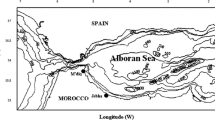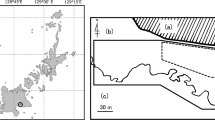Abstract
The natural feeding of 485 Octopus mimus (164 to 3088 g) was studied in relation to the species' life cycle and environmental seasonal variations off the north of Chile from autumn 1991 to summer 1992. Analysis of digestive-tract contents revealed that O. mimus preyed upon 25 different prey items belonging to five zoological groups (Teleostei, Mollusca, Crustacea, Echinodermata and Polychaeta). Cannibalism was only occasional. The results indicate that the diet and food intake of this species are significantly affected by sex and maturation. Senescent individuals ingest a small amount of food, and their diet is mainly based on small, not very motile prey. The food intake, expressed as body weight, of non-senescent individuals is higher in females than in males. Seasonal changes in sea-water temperature seem to be followed by adjustments in food intake. Like other Octopus species, O. mimus appears to be an opportunistic predator.
Similar content being viewed by others
References
Ambrose RF (1984) Food preferences, prey availability and the diet of Octopus bimaculatus Verril. J exp mar Biol Ecol 77: 29–44
Ambrose RF (1986) Effects of octopus predation on motile invertebrates in a rocky subtidal community. Mar Ecol Prog Ser 30: 261–273
Ambrose RF, Nelson BV (1983) Predation by Octopus vulgaris in the Mediterranean. Pubbl Staz zool Napoli (I: Mar Ecol) 4: 251–261
Arancibia H (1984) Estudio de talla y peso de primera madurez sexual en el pulpo Octopus vulgaris Cuvier, 1797. Servicio Nacional de Pesca de Chile (SERNAP), Santiago (Final Rep)
Arntz WE, Valdivia E, Zeballos J (1988) Impact of El Niño (1982–83) on the commercially exploited invertebrates (mariscos) on the Peruvian shore. Meeresforsch Rep mar Res 32: 3–22 (Ber dt wiss Kommn Meeresforsch)
Barber RT, Chávez F (1986) Ocean variability in relation to living resources during the 1982–83 El Niño. Nature, Lond 319: 279–285
Borer KT (1971) Control of food intake in Octopus briareus Robson. J comp Physiol Psychol 75: 171–185
Castro BG, Guerra A (1990) Diet of Sepia officinalis (Linnaeus, 1758) and Sepia elegans Blainville, 1827 (Cephalopoda, Sepioidea) from the Ria de Vigo (NW Spain). Scientia mar 54: 375–388
Cortez T, Cotton W, Praker U (1992) Diagnóstico de la pesquería del pulpo de la I región de Chile. SERPLAC-UNAP (Final Rep) Department of Marine Sciences, University of Arturo Prat, Iquique, Chile
Crow ME (1982) Some statistcal techniques for analyzing the stomach contents of fish. In: Caillet GM, Simenstad CA (eds) Fish food habits studies. Proceedings of the Third Pacific Workshop. Washington Sea Grant Publication. University of Washington, Washington, pp 8–15
Guerra A (1975) Determinación de las differentes fases del desarrollo sexual de Octopus vulgarisLamarck, mediante un índice de madurez. Investigación pesq 39: 397–416
Guerra A (1978) Sobre la alimentación y el comportamiento alimentario de Octopus vulgaris. Investigación pesq 42: 351–364
Guerra A, Cortez T, Hochberg F, Mangold K (1995) Redescription of Octopus mimus Gould, 1952 (Cephalopoda: Octopodidae) from the west coast of South America. Veliger (in press)
Hyslop EJ (1980) Stomach content analysis — a review of methods and their application. J Fish Biol 17: 411–429
Iribarne OO, Fernández ME, Zucchini H (1991) Prey selection by the small Patagonian octopus Octopus tehuelchus d'Orbigny. J exp mar Biol Ecol 148: 271–282
Legendre L, Legendre P (1979) Ecologie numérique. Vol 1. Masson, Paris
Mangold K (1983) Food, feeding and growth in cephalopods. Mem natn Mus Vict 44: 81–93
Mangold K, Boletzky S von (1973) New data on reproductive biology and growth of Octopus vulgaris. Mar Biol 19: 7–12
Margalef R (1974) Ecología. Omega, Barcelona
Mather JA (1993) Octopuses as predators: implications for management. In: Okutani T, O'Dor RK, Kubodera T (eds) Recent advances in cephalopod fisheries biology. Tokai University Press, Tokyo, pp 275–282
Nigmatullin CM, Ostapenko AA (1976) Feeding of Octopus vulgaris Lam. from the Northwest African coast. Int Counc Explor Sea Comm Meet (Shellfish Benthos Comm) K: 6: 1–13
Nixon M (1987) The diet of cephalopods. In: Boyle PR (ed) Cephalopod life cycles. Vol 2. Academic Press, London, pp 201–220
O'Dor RK, Mangold K, Boucher-Rodoni R, Wells MJ, Wells, J (1984) Nutrient absorption, storage and remobilization in Octopus vulgaris. Mar Behav Physiol 11: 239–258
O'Dor RK, Wells MJ (1978) Reproduction versus somatic growth: hormonal control in Octopus vulgaris. J exp Biol 77: 529–540
Siegel S, Castellan NJ (1988) Nonparametric statistics for the behavioral sciences. McGraw-Hill Book, New York
Smale MJ, Buchan PR (1981) Biology of Octopus vulgaris off the east coast of South Africa. Mar Biol 65: 1–12
Sokal R, Rohlf F (1969) Biometry. The principles and practice of statistics in biological research. W.H. Freeman & Co, San Francisco
Summers WC (1983) Physiological and trophic ecology of cephalopods. In: Russell-Hunter WD (ed) The Mollusca. Vol 6. Academic Press, New York, pp 261–279
Tait RW (1986) Aspects physiologiques de la sénescence postreproductive chez Octopus vulgaris. Thèse de Doctorat de l'Université Paris VI, Paris
Thore S (1959) Cephalopoda. Reports of the Lund University Chile Expedition 1948–1949. Lunds Univ. Årsberätt 55: 1–19
Urban H-J (1994) Upper temperature tolerance of ten bivalve species off Peru and Chile related to El Niño. Mar Ecol Prog Ser 107: 139–145
Van Heukelem WF (1976) Growth, bioenergetics and life-span in Octopus cyanea and Octopus maya. Ph.D. dissertation. University of Hawaii, Hawaii
Wodinsky J (1977) Hormonal inhibition of feeding and death in Octopus: control by optic gland secretion. Science, NY 198: 948–951
Wodinsky J (1978) Feeding behaviour of broody female Octopus vulgaris. Anim Behav 26: 803–813
Author information
Authors and Affiliations
Additional information
Communicated by A. Rodriguez, Puerto Real
Rights and permissions
About this article
Cite this article
Cortez, T., Castro, B.G. & Guerra, A. Feeding dynamics of Octopus mimus (Mollusca: Cephalopoda) in northern Chile waters. Marine Biology 123, 497–503 (1995). https://doi.org/10.1007/BF00349228
Received:
Issue Date:
DOI: https://doi.org/10.1007/BF00349228




